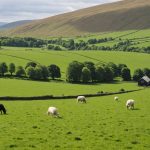Overview of the National Trust’s Role in Wildlife Conservation
The National Trust plays a crucial role in preserving UK biodiversity. Established in the late 19th century, the Trust has a long history of conservation efforts focusing on wildlife and natural habitats. This historical backdrop sets the stage for the Trust’s ongoing mission to protect and enhance the environment.
Central to the National Trust’s mission is the pursuit of wildlife conservation. Their objectives are clear: safeguard habitats, promote species diversity, and collaborate with local communities. This mission not only protects individual species but also strengthens the ecosystems they rely on. Through various initiatives, the Trust ensures that natural landscapes across the UK are maintained and restored for future generations.
Dans le meme genre : Essential Strategies for Eco-Friendly Farming Practices in the UK’s Upland Regions
Biodiversity is at the heart of the National Trust’s endeavors. The diversity of life forms, from plants to animals, underpins the health of ecosystems. Biodiversity is crucial for ecosystem resilience, providing pollination, seed dispersal, and climate regulation. The National Trust actively engages in projects that highlight the link between biodiversity and overall environmental health, advocating for both awareness and action. Through their dedicated work, the Trust remains a cornerstone in the conservation community, making significant strides in promoting and protecting biodiversity across the UK.
Key Conservation Projects
Conservation projects play a crucial role in safeguarding biodiversity and ensuring the longevity of natural habitats. Among various initiatives, habitat restoration and species protection stand out as pivotal efforts.
A découvrir également : Combating Wildlife Crime: Legal Measures Against Poaching of Protected Species in the UK
Project 1: Wetland Restoration
Wetland Restoration is a critical conservation project aimed at revitalizing crucial ecosystems. Located in diverse geographic areas with unique ecological requirements, these projects focus on enhancing habitat conditions for numerous species. Success metrics include increased biodiversity and improved water quality. Local communities are actively involved, with outreach efforts designed to educate and engage residents, fostering a collective sense of responsibility towards wetland health.
Project 2: Woodland Management
The Objectives of woodland management initiatives are to maintain and improve forest health. Conservation methods employed include controlled burns and selective logging to mimic natural processes. Monitoring results demonstrate positive biodiversity outcomes, with increased species richness and habitat quality. Continuous assessment ensures that woodland ecosystems remain resilient and sustainable.
Project 3: Coastal Protection
Coastal Protection projects address the unique challenges of preserving coastal ecosystems. These initiatives focus on habitat restoration and erosion control. Techniques such as dune stabilization and planting native vegetation are employed, effectively mitigating impacts from climate change and human activity. The conservation actions taken have resulted in healthier coastal environments, safeguarding biodiversity and reducing shoreline vulnerability.
Success Stories in Biodiversity
Exploring impactful efforts in biodiversity conservation showcases hopeful case studies and analyses. A prominent example of success stories in biodiversity is the reintroduction of the grey wolf in Yellowstone National Park. This initiative has drastically improved the ecosystem, leading to greater biodiversity improvement. Wolves help regulate prey populations, which allows vegetation to recover, thereby supporting various species. This serves as a prime illustration of how species reintroduction can bolster ecosystems.
Moreover, habitat restoration efforts have shown considerable success. Notably, the restoration of Coral Triangle areas has resulted in increased fish stocks and healthier marine ecosystems. This area is a testament to the conservation impact achieved when communities collaborate to revive natural habitats. Restoration not only benefits the immediate environment but also provides long-lasting ecological improvements.
Statistical evidence further supports these successes. Recent data indicates a positive trend in biodiversity as protected regions witness increased species richness and abundance. Percentages of particular species populations have risen with committed conservation actions, underlining that strategic interventions lead to tangible results.
These biodiversity improvement experiences emphasize the importance of sustained conservation, showcasing that success stories can drive enthusiasm and commitment toward future endeavors.
Partnerships and Collaborations
Engaging in conservation partnerships is vital for the sustainability of wildlife and natural habitats. These efforts often involve collaboration with both local communities and larger organizations, working hand-in-hand to achieve meaningful environmental impact.
Collaborating with Local Communities
Local communities play a pivotal role in conservation efforts. Community engagement is essential, particularly through volunteer programs that empower individuals to actively participate in protecting wildlife. Community-led initiatives have shown incredible results, driving change at the grassroots level.
One notable example is the involvement of local volunteers in creating and maintaining wildlife sanctuaries. These sanctuaries not only provide safe spaces for endangered species but also boost environmental awareness among residents. Successful community partnerships have also led to conservation education programs, fostering a deeper understanding and respect for nature in younger generations.
Working with Other Organizations
Another aspect of collaboration efforts is the establishment of strategic partnerships with environmental NGOs. These joint ventures often result in impactful conservation projects, enhancing the efforts made by individual entities. Key partnerships have facilitated the restoration of natural habitats and the reintroduction of native species.
Additionally, collaboration with NGOs has substantially influenced policy-making, encouraging governments to adopt more eco-friendly practices. By joining forces, these organizations and communities have significantly raised environmental awareness, promoting sustainable practices on a broader scale.
Future Goals and Commitments
The National Trust is setting its sights on ambitious future conservation goals aimed at fostering sustainable practices across its numerous sites. A fundamental aspect of these plans includes biodiversity pledges designed to safeguard diverse species and their habitats. Central to these initiatives are protective measures for endangered species, ensuring their continued survival and ecosystem balance.
The Trust’s long-term goals embrace a robust approach to wildlife and habitat protection. These involve increasing areas of protected land and integrating cutting-edge conservation technologies. Habitat restoration and rewilding projects reflect their commitment to reversing the damage done to ecosystems, championing the return of native species through innovative methods.
In terms of sustainability, the Trust is embracing strategies to enhance their future practices. This includes reducing carbon footprints by prioritising renewable energy sources and implementing eco-friendly land management techniques. Incorporating sustainability within estate management necessitates adopting sustainable building practices and improving waste management solutions.
By setting these biodiversity pledges and conservation goals, the National Trust demonstrates a strong commitment to environmental stewardship. The focus remains on creating harmonious environments where wildlife thrives alongside human activity, promising a sustainable future.
How to Support Wildlife Conservation
Supporting wildlife conservation involves various strategies that not only help protect the environment but also promote sustainable practices.
Donating to Conservation Efforts
Donating can be a powerful way to support wildlife conservation. Contributions fund essential projects like habitat restoration and species protection. Various donation opportunities exist, including one-time payments or regular contributions. Supporting targeted campaigns like reforestation or endangered species protection ensures that funds directly impact critical conservation efforts.
Volunteering for the National Trust
Volunteering provides a hands-on approach to support wildlife conservation. Many organizations, like the National Trust, offer programs where individuals can contribute to habitat preservation or educational initiatives. Volunteering benefits not only the environment but also personal growth, as you learn new skills and meet like-minded individuals. Current volunteers often share stories of personal fulfillment and the tangible change they witness firsthand.
Public Awareness and Advocacy
Raising public awareness and inciting advocacy are pivotal to support wildlife conservation. Engage your community by organizing events or sharing information on social media. Advocating includes contacting lawmakers to stress the importance of wildlife protection laws. Activism plays a vital role, mobilizing individuals to work towards effective conservation strategies and ensuring sustainable practices are prioritized.











